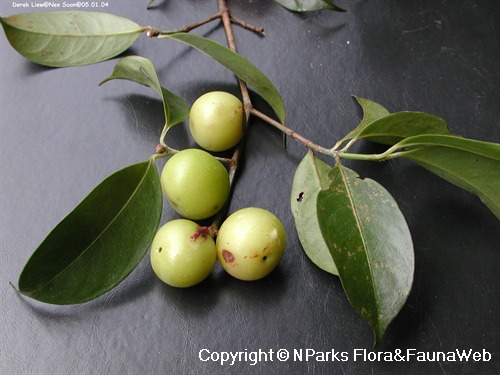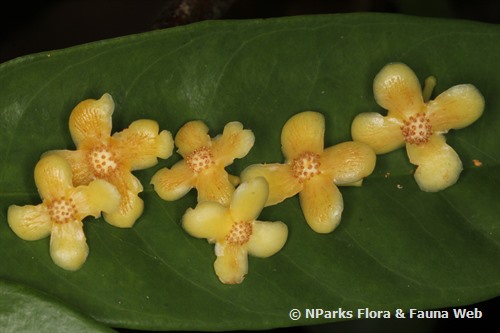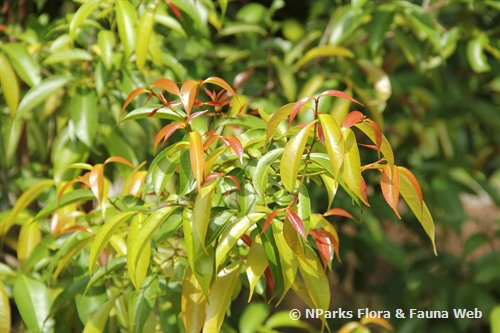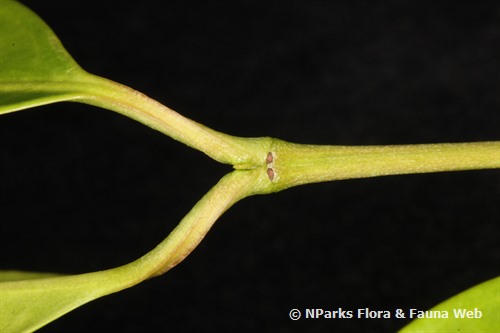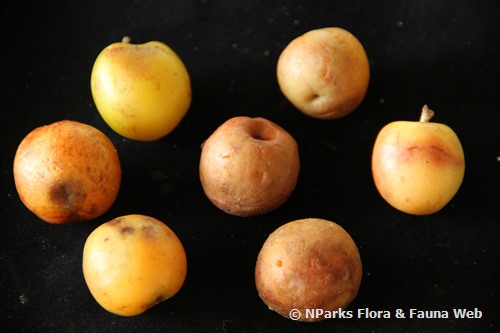
Back
Garcinia parvifolia (Miq.) Miq.
| Family Name: | Clusiaceae (Guttiferae) |
| Common Name: | Wild Yellow Kandis, Kandis, Assam Kandis |
Name
Classifications and Characteristics
| Plant Division | Angiosperms (Flowering Seed Plants) (Dicotyledon) |
|---|---|
| Plant Growth Form | Tree (Big (>30m)) |
| Lifespan (in Singapore) | Perennial |
| Mode of Nutrition | Autotrophic |
| Plant Shape | Irregular |
| Maximum Height | 33 m |
Biogeography
| Native Distribution | Sumatra, Peninsular Malaysia, Singapore, and Borneo |
|---|---|
| Native Habitat | Terrestrial (Primary Rainforest, Secondary Rainforest, Freshwater Swamp Forest) |
| Preferred Climate Zone | Tropical |
| Local Conservation Status | Native to Singapore (Least Concern (LC)) |
Description and Ethnobotany
| Growth Form | It is a tree up to 33 m tall. |
|---|---|
| Foliage | Its opposite, stalked leaves have thinly leathery leaf blades that are dark green, narrowly elliptic, and 515 by 1.95.7 cm. Its veins are inconspicuous. |
| Flowers | Its flowers are white-yellow. Both its male and female flowers grow in clusters at the leaf axils. Its male flowers are 7–10 mm wide, while female flowers are 4–6 mm wide. |
| Fruit | Its yellow-orange fruits are elliptic and 17 mm across. Its stigma is sunken and concealed. Its fruits contain 1–8 seeds which are covered with white pulp. |
| Habitat | It grows in primary and secondary forests, up to 600 m altitude. |
| Associated Fauna | Its flowers are insect-pollinated, and fruits eaten by mammals. |
| Cultivation | It can be propagated by seed. |
| Etymology | Garcinia, commemorating Laurent Garcin (16831751), a French botanist who travelled widely in India; Latin parvus, small; Latin folium, leaf |
| Ethnobotanical Uses | Edible Plant Parts : Edible Fruits Food (Fruit or Vegetable): Its sour fruits are edible. (Herb or Spice): Its fruits are used flavouring for rice. Timber & Products: Its timber is used in the construction of houses. |
Landscaping Features
| Landscaping | It is suitable for parks. |
|---|---|
| Desirable Plant Features | Ornamental Fruits, Ornamental Form |
| Landscape Uses | Parks & Gardens |
Fauna, Pollination and Dispersal
| Pollination Method(s) | Biotic (Fauna) |
|---|---|
| Seed or Spore Dispersal | Biotic (Fauna) |
Plant Care and Propagation
| Light Preference | Full Sun, Semi-Shade |
|---|---|
| Water Preference | Moderate Water |
| Plant Growth Rate | Moderate |
| Rootzone Tolerance | Moist Soils, Well-Drained Soils, Fertile Loamy Soils |
| Propagation Method | Seed |
Foliar
| Foliage Retention | Evergreen |
|---|---|
| Mature Foliage Colour(s) | Green |
| Mature Foliage Texture(s) | Leathery, Thin |
| Foliar Type | Simple / Unifoliate |
| Foliar Arrangement Along Stem | Opposite |
| Foliar Attachment to Stem | Petiolate |
| Foliar Shape(s) | Non-Palm Foliage (Elliptical) |
| Foliar Venation | Pinnate / Net |
| Foliar Margin | Entire |
| Leaf Area Index (LAI) for Green Plot Ratio | 4.0 (Tree - Dense Canopy) |
Floral (Angiosperm)
| Flower & Plant Sexuality | Unisexual Flowers , Monoecious |
| Flower Colour(s) | Cream / Off-White, White, Yellow / Golden |
|---|
| Flower Grouping | Cluster / Inflorescence |
| Flower Location | Axillary |
| Flower Symmetry | Radial |
Fruit, Seed and Spore
| Mature Fruit Colour(s) | Orange, Yellow / Golden |
|---|---|
| Fruit Classification | Simple Fruit |
| Fruit Type | Fleshy Fruit , Non-Accessory Fruit |
Image Repository
Others
| Master ID | 1636 |
|---|---|
| Species ID | 2929 |
| Flora Disclaimer | The information in this website has been compiled from reliable sources, such as reference works on medicinal plants. It is not a substitute for medical advice or treatment and NParks does not purport to provide any medical advice. Readers should always consult his/her physician before using or consuming a plant for medicinal purposes. |

